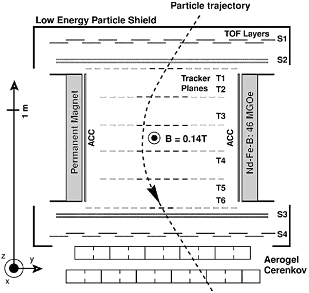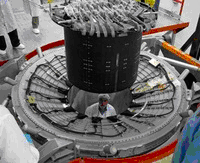

It is one of the questions the Alpha Magnetic Spectrometer cosmic particle detector (call AMS-01) has to answer. For the first time, the instrument of which the conception is similar to the particle detectors used on the ground (like in the CERN research centre) is positioned in orbit. Aboard the American Space shuttle Discovery from June 2nd to June 12th, 1998, with an altitude of around 400 km over the Earth, it recorded traces of millions of cosmic particles coming from the galactic Space.
The cosmic rays are made up of two components:
- a galactic permanent one, made up of very energetic particles ejected by stars, supernovas and other sources some of which may be still unknown.
- a more sporadic one related to the sun activity.
Those particles are of various kinds, mainly hydrogen (protons) and helium (alpha particles) nuclei but also more heavy ones. They travel near to the speed of light. It is very difficult to observe them directly from Earth because they interact with the atmosphere. Balloon experiments were performed in the upper atmosphere (40 km over the Earth) but they showed that the cosmic radiation produces secondary particles in every directions when entering the Earth's atmosphere.
The AMS-01 magnetic spectrometer was designed to measure the cosmic particle flux of all types, with high accuracy and high statistics, over a wide energy range (hundreds of gigaelectron volts).
No antimatter but unexpected results
The AMS-01 performed a lot of measures, in particular on cosmic helium nuclei. Helium, before hydrogen, is the most abundant element in the universe. Almost all the helium volume was formed in the very first instants of the universe. A sample of some 3 million cosmic helium nuclei was collected. The AMS-01 did not detect any primordial antimatter but the experiment established an upper limit of 1.1x10-6 for the antihelium/helium flux ratio in the universe.
The information collected by the AMS-01 also impacted the knowledge of our Earth's environment. The charged particles in the cosmic radiation are bended by the Earth's magnetic field like the pointer of the compass.
If particles possess energy which is greater than a certain threshold, i.e. the magnetic cutoff energy, they will cross through the Earth's magnetosphere. But if little energy is available, they tend to follow the magnetic field and reach the poles.
During its revolution around the Earth, the AMS-01 studied the cosmic radiation coming from different latitudes in the vicinity of the planet. Measures disclosed an unexpected behaviour of particles, in particular concerning their reaction entering the Earth's magnetic field according to the latitude.
The experiment found, against all odds, a high level of protons in the energy field on the GeV scale, in almost all latitudes. Even more surprising, for protons of less than 8 GeV of energy (below the geomagnetic cutoff), in an equatorial plane of 4,000km latitude at an altitude of approximately 400km, the AMS-01 detected as much upstream (from Earth) as downstream particles, as if those particles were balanced populations, trapped in the Earth's magnetic field.
The AMS-01 was the first step toward the realization a technological demonstration and it perfectly well played its role because the instrumentation of the spectrometer and all its functions were tested in-flight until data were received. The physical conditions of the experiment and the spectrometer response were assessed (in particular to temperatures, according to the shuttle orientation).
The AMS-02 takes over
Since then, even more efficient and in an higher energy field (TeV, tera-electronvolt) the AMS-02 instrument was launched with the last mission of the US Space shuttle Endeavour on May 16th, 2011 and has been set up for many years to come on the International Space Station.

The AMS-02 brings together some 600 investigators. The instrument was essentially assembled at CERN research centre and tested at ESA at the European Space Research and Technology Centre (ESTEC). France played a major role in the conception and the building of various parts of the instrument thanks to four laboratories of the French Center for Scientific Research (CNRS):
- LAPP (Laboratoire d'Annecy-le-Vieux de Physique des Particules), Annecy-le-Vieux, France (CNRS - Université de Savoie), for the electromagnetic calorimeter;
- LPSC (Laboratoire de Physique Subatomique et de Cosmologie), Grenoble, France, (CNRS - Université Joseph Fourier), for the Ring Image Cherenkov detector
- LUPM (Laboratoire Univers et Particules de Montpellier), Montpellier, France, (CNRS - Université Montpellier 2), for the Space GPS receiver
- CCIN2P3 (Centre de Calcul de l'Institut National de Physiaue Nucléaire et de Physique des Particules) of the CNRS, for a large part of the computing resources necessary for the experiment simulation and the physics preparation.
The AMS-02 will keep tracking down antimatter and looking for a solution to the mystery of the dark matter: an invisible component of the universe which would represent around 80% of its total weight. If the dark matter was composed of new particles, the AMS-02 could detect it indirectly recording an anomaly in the cosmic rays flux. Speaking less speculatively, the experiment will open up new horizons on the universe giving a map of the sky in the cosmic radiation field, which will complement the light telescopes receive.
Contacts
- Fundamental physics program scientist: Sylvie Léon